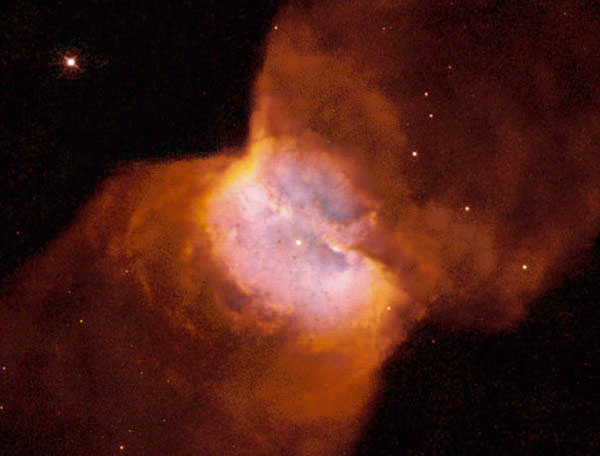Credit: Massimo Stiavelli (STScI),
Inge Heyer (STScI) et al.,
& the Hubble Heritage Team (AURA/ STScI/ NASA)
Explanation:
It may look like a butterfly, but it's bigger than our
Solar System.
NGC 2346 is a
planetary nebula made of gas and
dust
that has evolved into a
familiar shape.
At the heart of the
bipolar planetary nebula
is a pair of close stars orbiting each other
once every sixteen days.
The tale of how the butterfly blossomed probably
began millions of years ago, when the stars were farther apart.
The more massive star expanded to encompass its
binary companion,
causing the two to spiral closer and expel
rings of gas.
Later, bubbles of hot gas emerged as the core of the massive
red giant star became uncovered.
In billions of years, our
Sun will become a
red giant and emit a
planetary nebula - but probably not in the shape of a
butterfly, because the
Sun has no
binary star companion.
& the Hubble Heritage Team (AURA/ STScI/ NASA)
1999 2000 2001 2002 2003 2004 2005 2006 2007 2008 2009 2010 2011 2012 2013 2014 2015 2016 2017 2018 2019 2020 2021 2022 2023 2024 2025 |
Январь Февраль Март Апрель Май Июнь Июль Август Сентябрь Октябрь Ноябрь Декабрь |
NASA Web Site Statements, Warnings, and Disclaimers
NASA Official: Jay Norris. Specific rights apply.
A service of: LHEA at NASA / GSFC
& Michigan Tech. U.
|
Публикации с ключевыми словами:
Планетарная туманность - NGC 2346 - planetary nebula
Публикации со словами: Планетарная туманность - NGC 2346 - planetary nebula | |
См. также:
Все публикации на ту же тему >> | |
